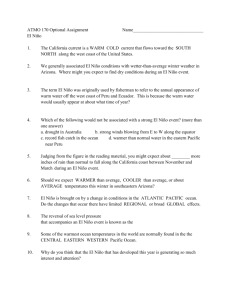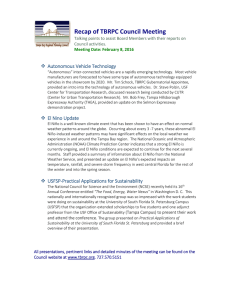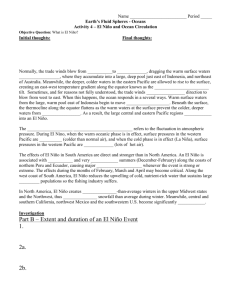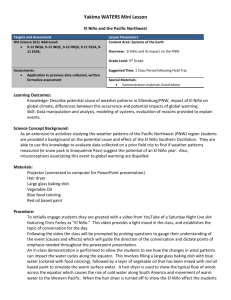Sp 16 Wk 9_Infancy Temp_Attach.pptx
advertisement
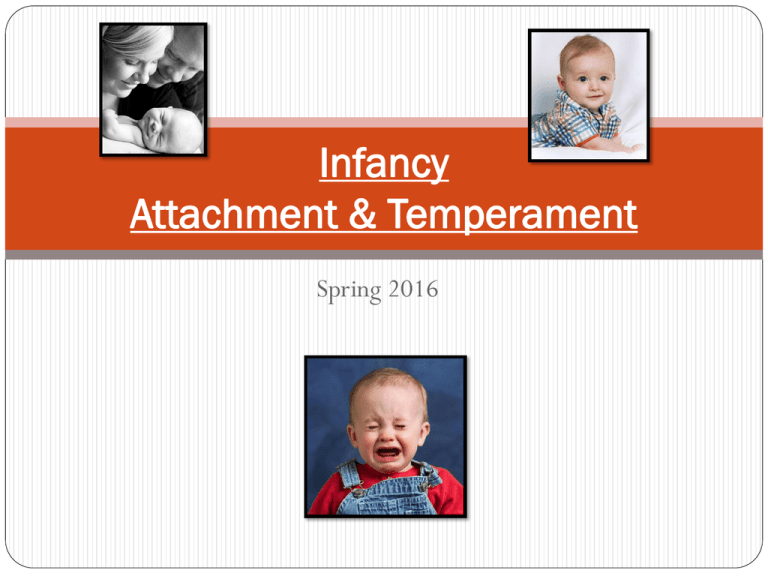
Infancy Attachment & Temperament Spring 2016 Infancy – Piaget’s Sensory Sub-stages 1) Reflexive schemes (0- 1 mos.) - Centering around the infant’s own body…(sucking, rooting & grasping) 2) Primary circular reactions (1- 4 mos.)- Repeated movements, centering around infant’s body & objects…by chance 3) Secondary circular reactions (4-8) - Infants repeat actions that include objects in their environment; focus on reactions from the object & reactions of other’s in the environment… 4) A child’s ability to relate 2 actions (8-12 mos.) Intentional behavior…moving Piaget’s hand out of the way to get a desired object. (Bowlby )Attachment/Fijación (Apego) The emotional bond between an infant and their primary caregiver…Es una relación emotiva y social que perdura Phases of attachment/ Fases de Fijación (Apego) Phase 1 (Birth – 2 mos.): Indiscriminate Social Responsiveness/ Reaccion Social Indistinto Phase 2 (2-7 mos.): Discriminate Social Responsiveness/ Respuesta Social Discriminado Phase 3 (8-24 mos.): Focused Attachment/ Fijación (Apego) Enfocado Attachment is connected to an infant’s emotional & physical development…el apego es relacionado a el desarrollo emotivo y físico. Wariness of strangers/ Cuidado o miedo de extraños-infant will cry and retreat to the mother in the presence of a stranger. Separation protest (anxiety)/ Protesta la separación- the infant will cry & look for the mother when they are separated. Attachment styles: - Secure - Insecure - Avoidant/Ambivalent Temperament/Temperamento The aspect of personality, which includes emotional expressiveness & responsiveness to environmental stimulation; also refers to one’s “personality”. Es la conformacíon reactiva de un individuo, el aspecto espontáneo de su personalidad. Procede de la combinación de disposiciones características emanadas de sus apetitos, emociones, y estado de ánimo. Describes the behavioral style, reflecting how a child does something (response); es una descripción de el estilo de comportamiento. Temperamental style develops with age; predictions based on stability of temperament are more accurate after 24 mos. of age; se desarrolla conforme la persona crece. Stability of temperament style relies on: child’s experience, environment, parenting practices & goodness of fit (“buen juego con su ambiente, etc.”); estabilidad depende en la experiencia del niño. Goodness of fit/ Juego adecuado- a concept describing the relation between a child’s temperament & his or her social and environmental surroundings (caregiver/home, parenting practices, community, etc.) Thomas & Chess: 9 dimensions of temperament Activity/ Actividad - refers to how active a child is Nivel de actividad… Intensity/ Intensidad - refers to the energy level of a child’s response Nivel de energía de la respuesta del niño… Sensitivity/ Sensibilidad - refers to how much stimulation is needed to evoke a child’s response… El nivel de estimulacion que se requiere para que responda un niño… Adaptability/ Adaptabilidad - refers to how much time a child takes to adjust to changes/intrusions/restrictions/transitions, etc. Se refiere a cuanto tiempo le toma al niño ajustar a cambios/restricciónes/limitaciónes, transiciónes, etc. Approach -Withdrawal/ Aproximació - Retirarse refers to a child’s response to new things: food, person, toy or place Se refiere a como el niño responde a cosas nuevas… Persistence/ Persistencia - refers to a child’s tendency to continue an activity until it is finished La tendencia del niño, que continue con una actividad haste que acabe. Distractability/ Distracción- refers to how easily a child is drawn away from an activity he or she is involved in Que tan fácil se distrae el niño… Rhythmicity/ Rítmico- refers to the predictability of a child’s sleep-wake cycle, hunger/eating pattern, & elimination pattern. El nivel que se puede predecir los ciclos del niño… Mood/ Humor- refers to a child’s tendency to be smiling and cheerful as opposed to unsmiling & thoughtful La tendencia del niño, de sonreír, estar de buen humor 3 main categories were identified/ 3 Categorías: The easy child/ El niño fácil The difficult child/ El niño difícil The slow-to-warm-up child/ El niño lento para calentarse


